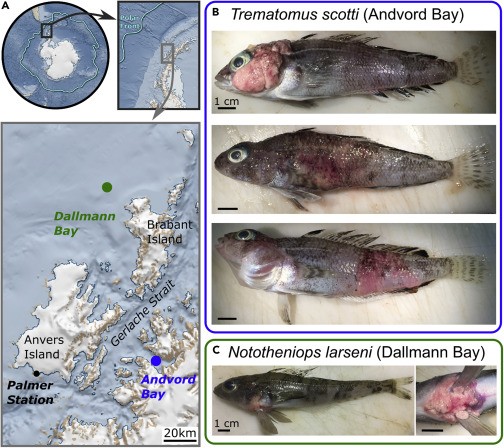A new study suggests that climate change is the culprit behind the dramatic change in fish species' health in the Antarctic waters. The results were collected through an extensive decade-long study led by scholars from the University of Oregon.
The study focused on the species that inhabit the West Antarctic Peninsula. Most of the fish groups observed had already adapted to the harsh environment of the polar region caused by human-induced climate change.
Despite the fish groups surviving the significant changes, the team was astounded by the bizarre shifts in the species' anatomy. In 2018, scientists discovered what appears to be skin tumors spreading in the skin of large fish populations.
Strange Parasitic Illness Among Antarctic Fish

(A) Animal collection sites. The cyan line marks the Polar Front. (B) Three specimens of crowned notothen Trematomus scotti from Andvord Bay and (C) a painted notothen Nototheniops larseni from Dallmann Bay. Tumors in T. scotti affect skin anywhere on the body. Tumors in N. larseni developed below the head and between the pelvic fins.
Upon confirming the outbreak, the marine biologists collaborated with pathologists and virologists to learn more about this strange phenomenon. According to their findings, the skin tumors were caused by a parasitic illness that escalated to an alert that never emerged in any regions across Antarctica, PhysOrg reports.
The authors said that the major factor responsible for this abnormal disease in the Antarctic fishes is the melting ice and disturbance of water composition.
University of Oregon's Institute of Neuroscience specialist and lead author of the study Thomas Desvignes explained that animals, including the Antarctic fishes, are vulnerable to disease when their living conditions become more and more difficult.
Fish species that are known to inhabit parts of waters across and near the Antarctic region are categorized as notothenioids. This group of creatures evolved in ways that made them immune to the natural conditions in the polar waters. Among the defenses, they developed are the specialized proteins in their genes that prevent their blood from freezing.
ALSO READ: Distinct Polar Bear Group in Greenland Survives Melting Sea Ice Through Glacier Chunks
Climate Change Suspected as Reason Behind Skin Tumor Disease in Polar Fishes
In a 2018 field research, the team focused on a small fjord located in the West Antarctic Peninsula. During the season, the place was supposed to be filled with ice.
Desvignes said that one of the fish species they saw was abundant on the field, but most of them had huge tumors spreading across random parts of their bodies, Daily Mail reports.
Arizona State University's Center for Evolution and Medicine and School of Life Sciences specialist Arvind Varsani, who served as co-author of the study, said that institutes lack data about the diseases associated with the swimmers they found.
After testing, the fishes were diagnosed with a poorly-understood parasitic condition known as X-cell disease, an illness reported in Norway and Iceland wild fisheries. This problem is yet to be resolved due to the limited data on how it infects and transmits.
The authors imply that the main factor that induces the tumors is the shift in the composition of Antarctic waters. Moreover, the bottom water that is supposed to be cold for fish living on it warms faster than expected.
Further studies will be held to learn more about the tumor outbreak, pathogens in separate species and other places, and the specifics that allow the disease to be transmitted across populations at an alarming rate.
The study was published in iScience, titled "A parasite outbreak in notothenioid fish in an Antarctic fjord."
RELATED ARTICLE: Bolstering Plant Immunity Vs. Climate Change Could Help Plants Fight Back Diseases
Check out more news and information on Climate Change in Science Times.














